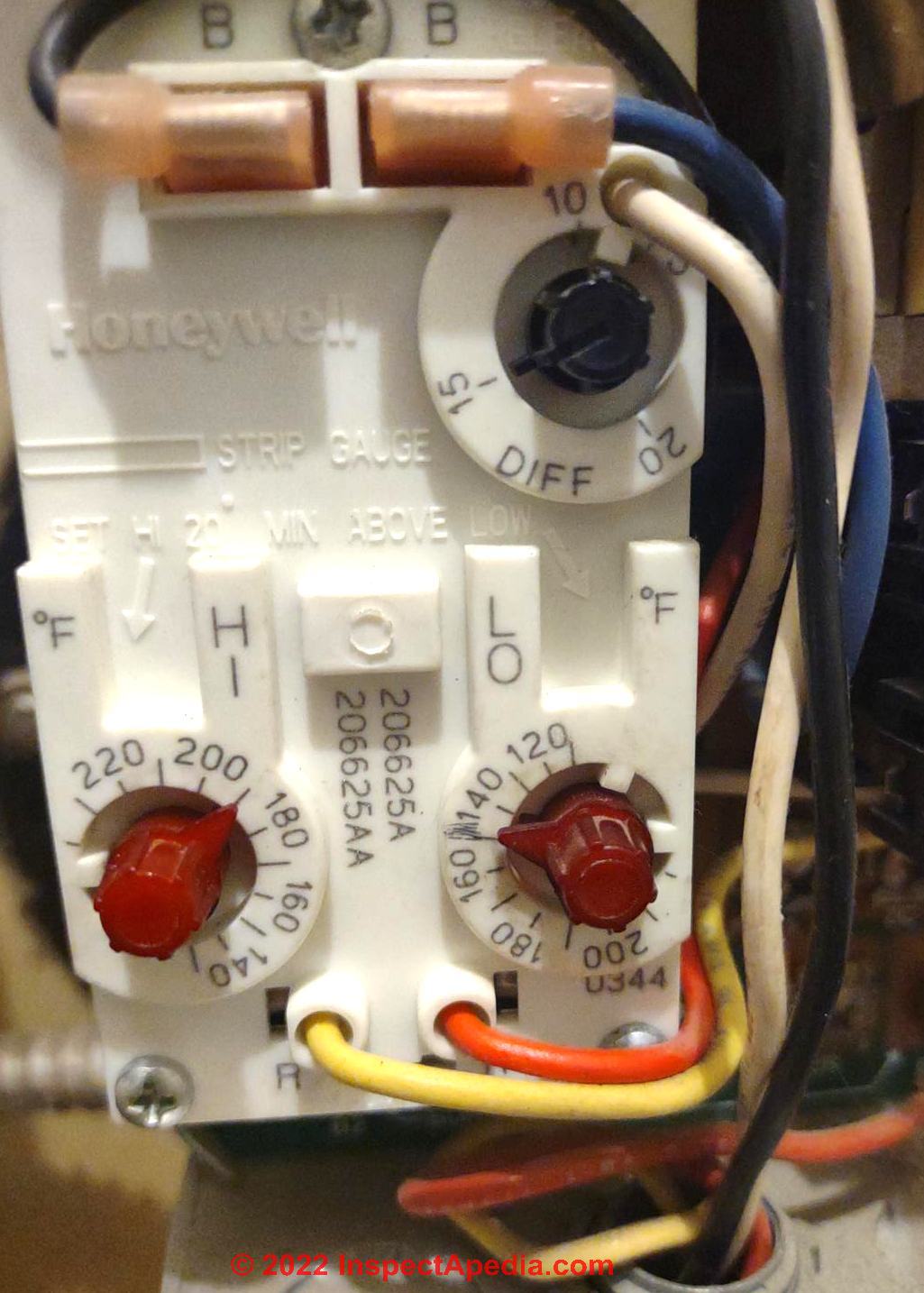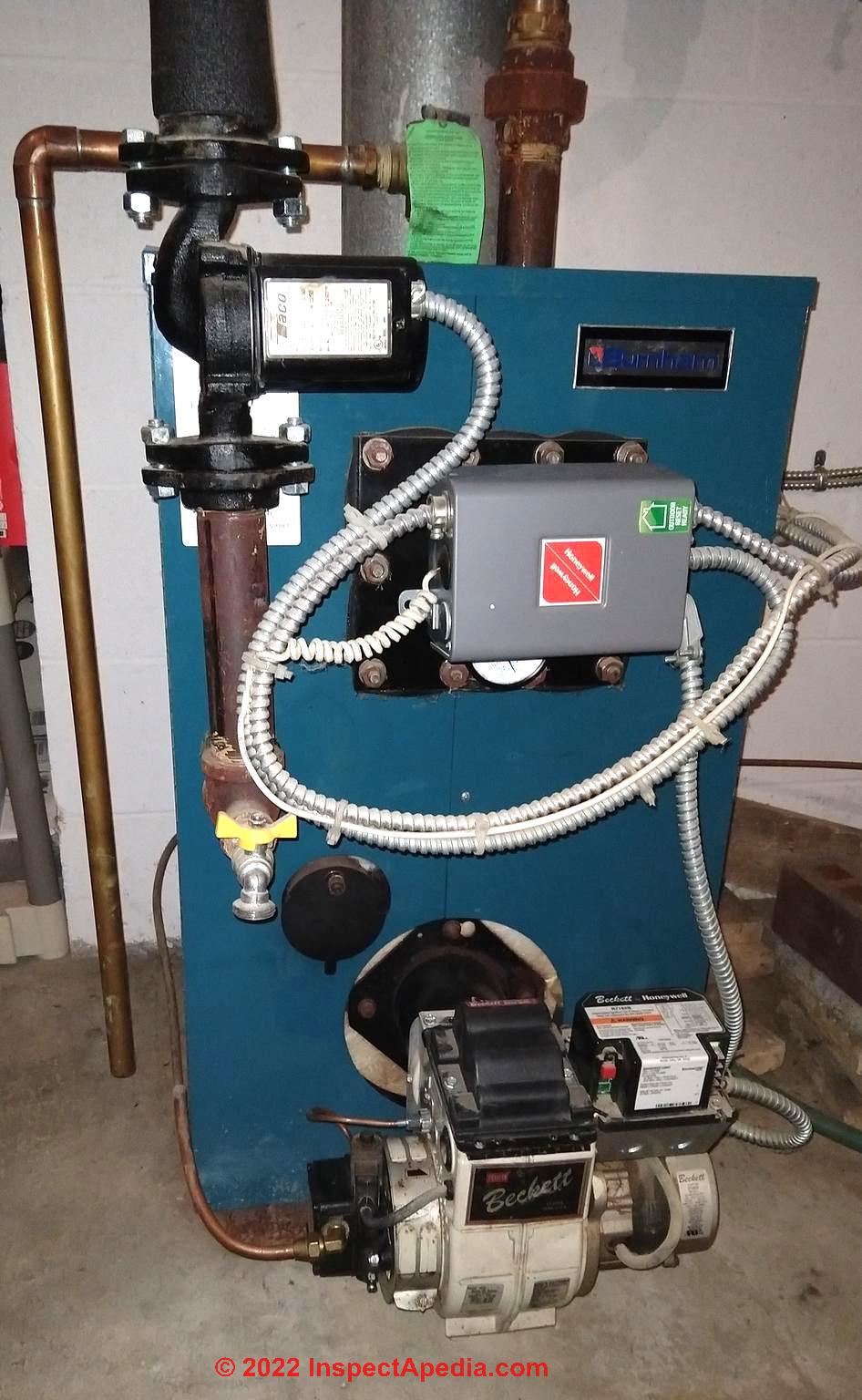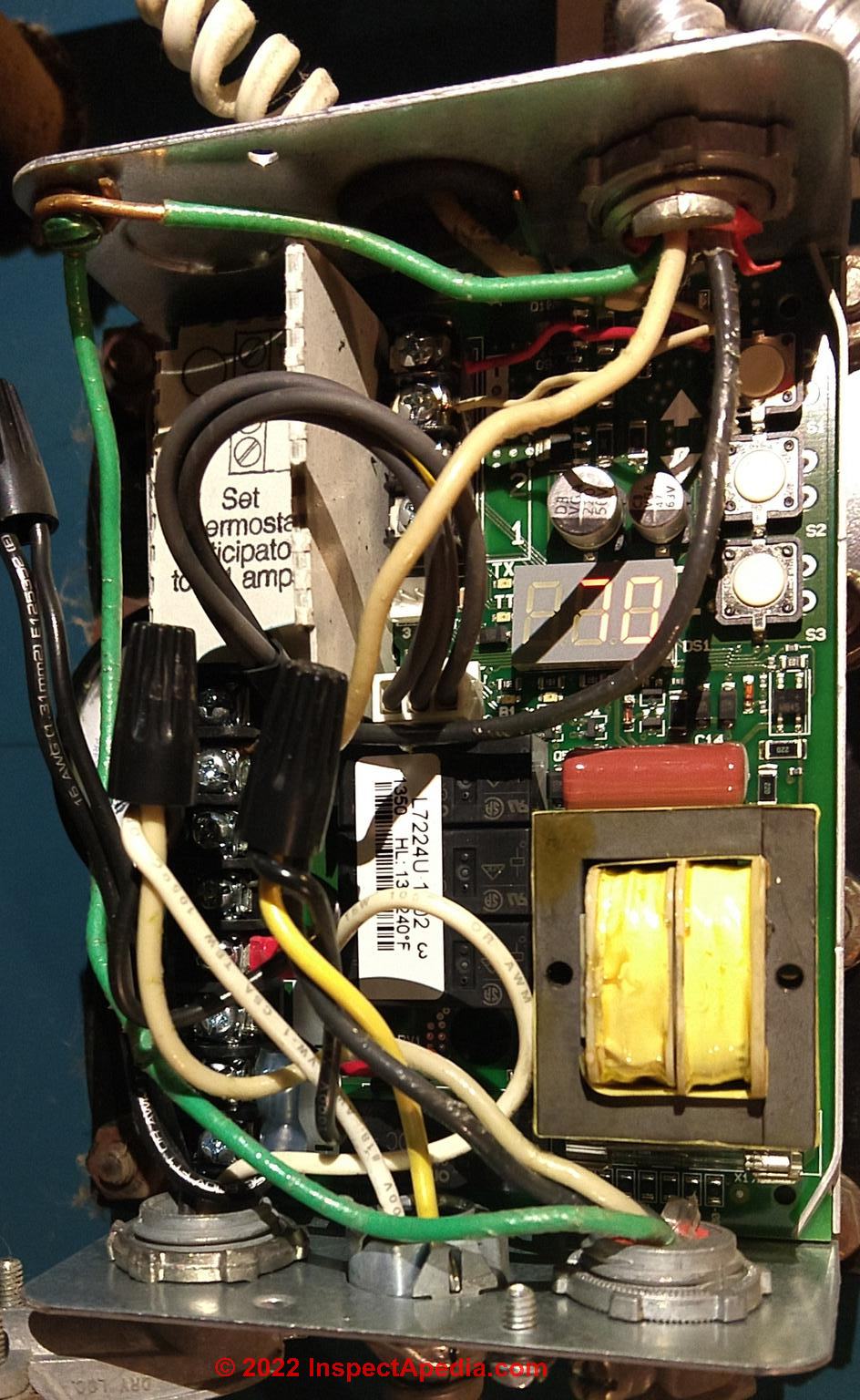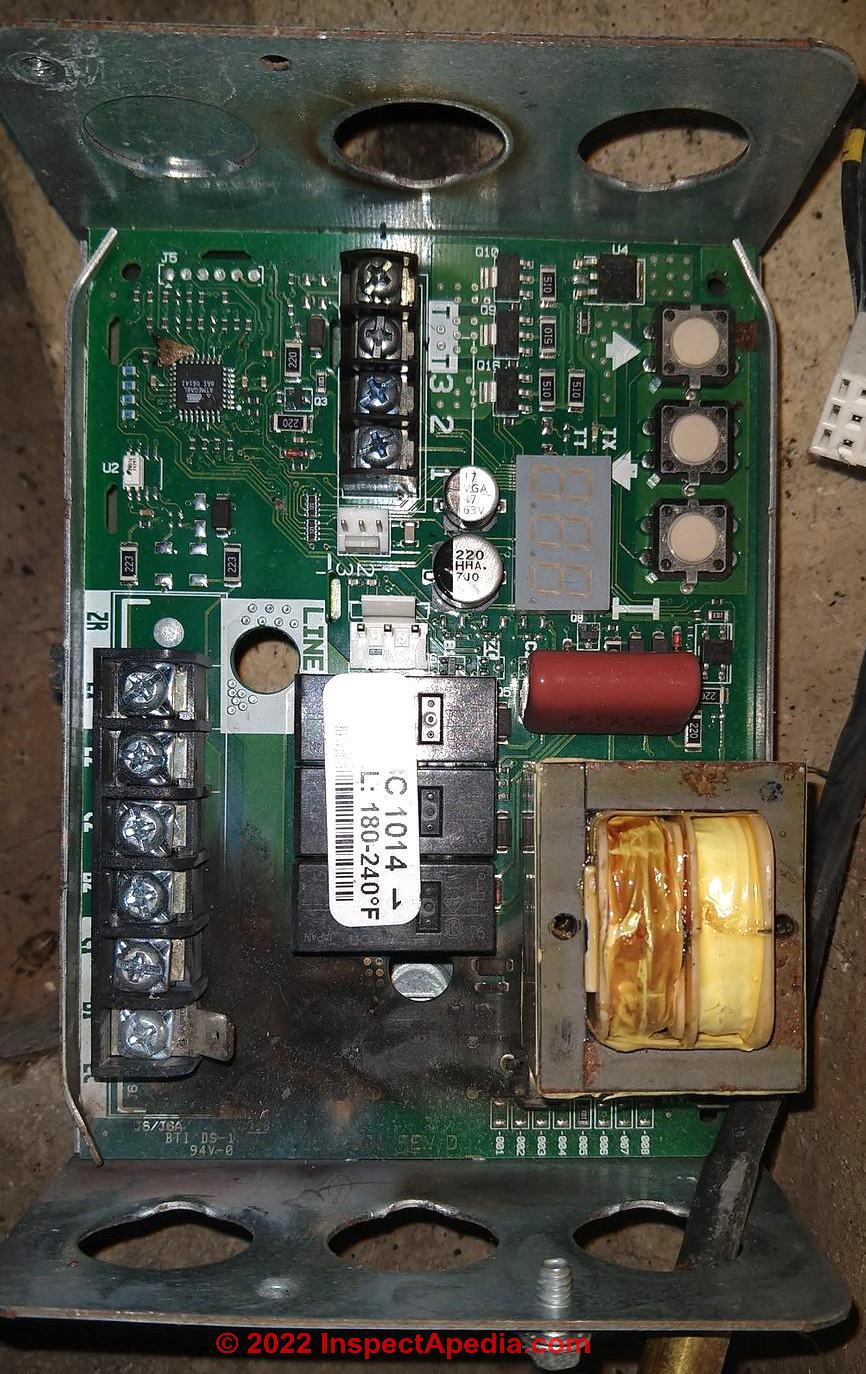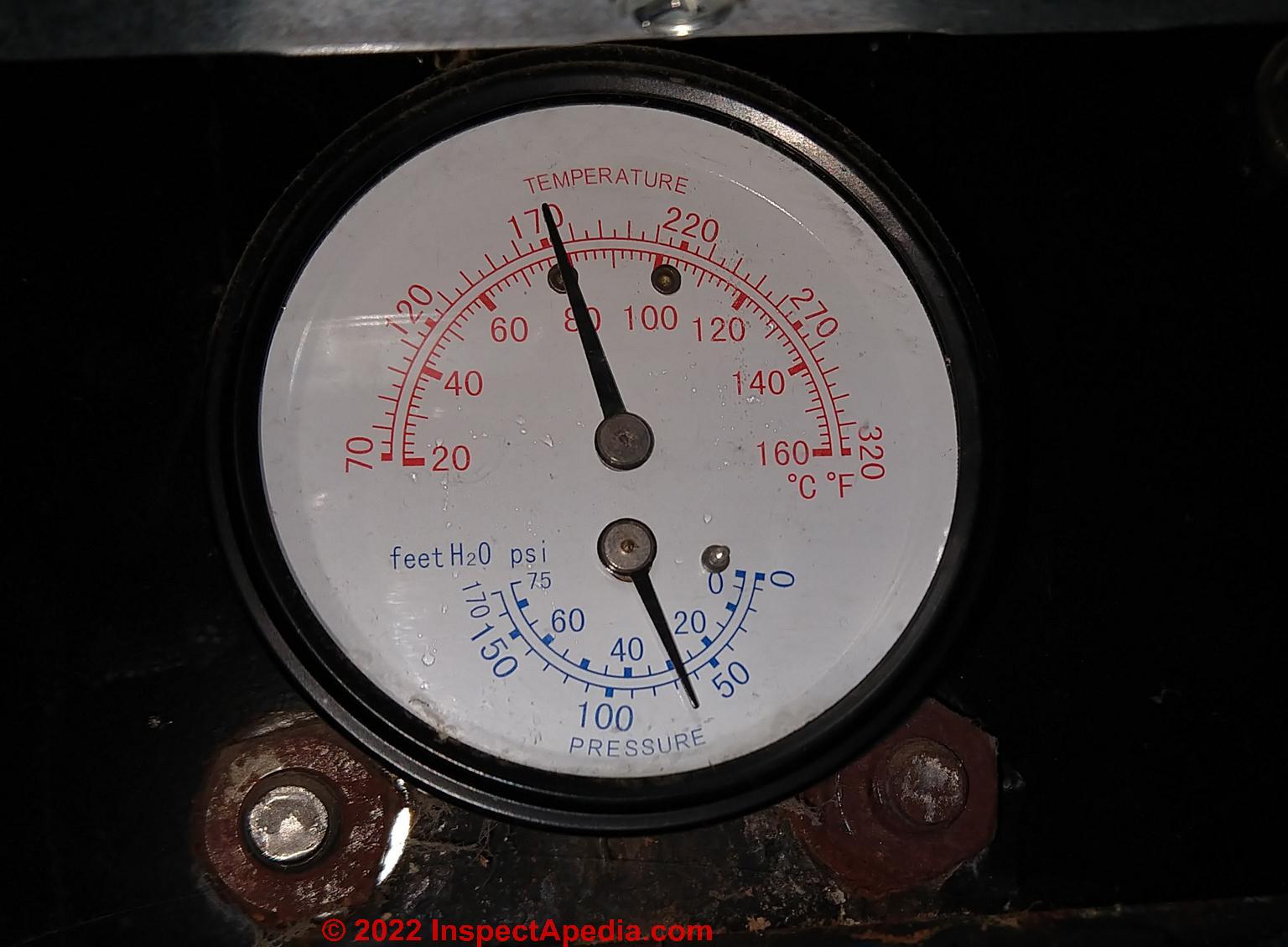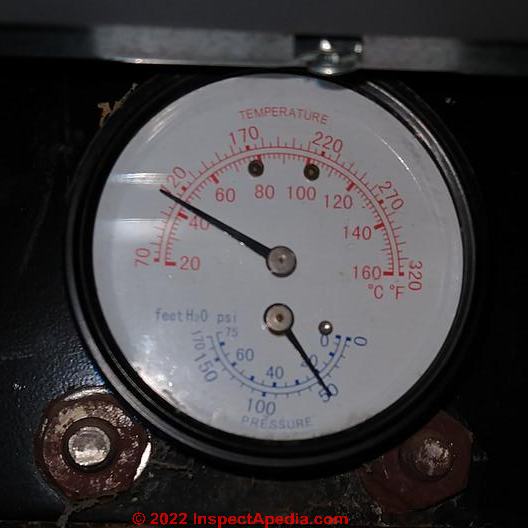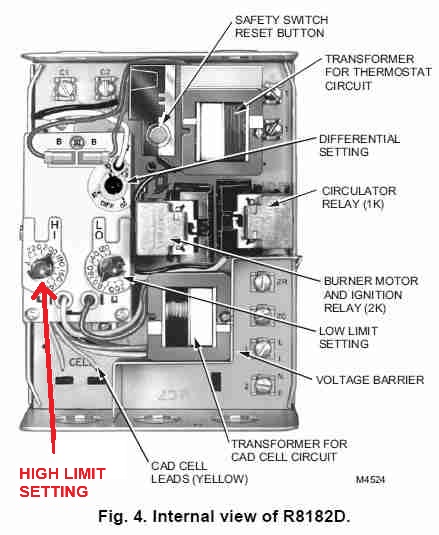 Q&A on High, Low, & DIFF Settings on a Heating Boiler Aquastat
Q&A on High, Low, & DIFF Settings on a Heating Boiler Aquastat
- POST a QUESTION or COMMENT about the best settings for aquastat controls on heating boilers
FAQs about choosing the best settings for a heating boiler aquastat control:
This article series explains exactly how to choose the best settings for a heating boiler aquastat - the combination control that sets boiler temperature and may also control hot water production via a tankless coil on the heating boiler.
InspectAPedia tolerates no conflicts of interest. We have no relationship with advertisers, products, or services discussed at this website.
- Daniel Friedman, Publisher/Editor/Author - See WHO ARE WE?
Questions & Answers About What Settings To Use on a Heating Boiler Aquastat Combination Control
These questions & answers were posted originally
at AQUASTAT HI LO DIFF SETTINGS - please be sure you review the advice given there.
The illustration at page top shows a the "HIGH" or "HI" setting on a Honeywell R8124A combination heating control, also called an "aquastat".
Article Contents
- AQUASTAT SETTING ACCURACY FAQs
- AQUASTAT SETTINGS for ABANDONED or NO TANKLESS COIL FAQs
- AQUASTAT SETTINGS for COMBI WOOD-OIL BOILERS FAQs
- AQUASTAT SETTINGS to GET THE MOST HOT WATER FAQs - run out of hot water? water not hot enough?
- AQUASTAT SETTINGS for FUEL SAVINGS FAQs
- AQUASTAT SETTINGS for MORE HEAT FAQs
- AQUASTAT SETTINGS for TANKLESS COIL as PRE-HEATER for WATER HEATER FAQs
- AQUASTAT SETTING TROUBLESHOOTING FAQs - airbound boiler, boiler runs hot, boiler short cycles
- AQUASTAT SETTING REPAIR FAQS - general questions, settings impact on boiler short cycling or other operating problems
- AQUASTAT SETTING VS SENSOR PROBE FAILURE FAQS - Boiler won't turn on or won't turn off at aquastat settings
- BEST SETTINGS FAQS - overall best numbers at which to set each dial
- SEASONAL AQUASTAT SETTING FAQs - changes for summer or winter?
...
Economical Aquastat Settings FAQs
Are my aquastat settings correct to optimize heating fuel use?
Trying to get the best optimal settings for my Weil McLain boiler here in northwest NJ. I do not have a hot water heater or a wood burning ng stove. The burner was just replaced last year with a carllin, EZ pro model #J98022 EZ-hpw.
Just replaced the filter. Here is a pic of my settings.
I believe they are set @
high 190
low 140
Diff set @ 15
Is this correct? Just trying to save a few bucks and optimize my fuel consumption. Thanks in advance and have some great holidays! - On 2022-12-22 by Joseph Donahue scrunchd@gmail.com -
Reply by InspectApedia Publisher - how do I optimize my fuel consumption
@Joseph Donahue scrunchd,
No, the settings you quote for that aquastat don't match the photo: In the photo the aquastat settings areHIGH 190°F
LO 150°F
DIFF 15°F
How to get the "most" hot water from a tankless coil on a boiler
To get the most hot water from a tankless coil system on a boiler you'd want to keep the boiler as hot as possible (close to 200 degF) so that the maximum amount of heat is stored in the boiler and thus is available for transfer to the domestic hot water supply through the coil.
So you'd set the HI to 200F. (No higher or the temperature relief valve will open).
And you'd set the DIFF down to its lowest number - say 10 - so that as boiler temperature drops the burner will come on as soon as possible.
That's not the most-economical setting, it's the "most hot water" setting.How to set the Aquastat for the the Most Economy
Here we have conflicting parameters.
First: Arguments for higher boiler temperatures:1.a. The thermal conductivity of hot water in heating baseboards or radiators is exponentially greater at higher temperatures
- that is, at hotter temperatures you get more-efficient heat transfer out of the boiler's water through the radiating device and into the occupied space.
1.b. A heating boiler operates most-efficiently when it's up to full operating temperature.So short "ON" cycles, especially less than 5 minutes for oil fired boilers and similarly for gas fired boilers, are inefficient. When the boiler comes on you want it to run for a longer period.
For example if your boiler turns on, heats up, and shuts off after 4 minutes that's quite inefficient, especially for oil-fired systems. A lot of your heating btus went up the chimney as incompletely-burned oil. Even if the boiler ran for 6 minutes, only 1 of those minutes was run at full efficiency (for oil).
So longer boiler on-cycles is better.
Second: arguments for lower boiler temperatures
Some add-on heating boiler efficiency improvement controls adjust the boiler operating temperatures in accordance with changes in the outdoor temperature, on the assumption that the control can still provide an adequately-long on-cycle while running the boiler at lower temperatures when outdoor temperatures are higher.
In my OPINON independent research supporting the net gain from these devices is still needed - citations are invited.
Finally:How to minimize heating cost for your building
1. Stop air infiltration losses
2. Install energy-efficient windows
3. Improve insulation, especially in attic and then in walls
4. Have the heating boiler cleaned and adjusted for optimum performance every year
See details at
AQUASTAT SETTINGS vs HEATING COST
HEATING COST SAVINGS METHODS - home
Read those articles and post your further questions, opinions, or criticism on those pages or here - we'll be glad to continue the discussion.
Honeywell R8182D - is 160 High and 140 Low with a difference of 15 efficient? Will it save heating oil?
For Honeywell R8182D - is 160 High and 140 Low with a difference of 15 efficient? Will it save heating oil? On 2022-11-18 by Anonymous -
Reply by InspectApedia (Editor) - what aquastat settings will save the most on heating oil?
@Anonymous,
No.
Watch out: if you set a DIFF of less than 20 degF. you risk locking out the circulator pump and your heating system wont' work properly.
Not only will that not save heating oil, it might actually use more heating oil, as without the circulator pump in operation people will crank up the thermostat even higher trying to get heat - which is arriving only by natural convection as the circulator isn't pulling hot water through the heating zone.
Take a look at AQUASTAT SETTINGS vs HEATING COST
for details on the question of "what aquastat settings will save the most on heating oil?"
You'll see that there are some conflicting factors:
Some companies like an automatic set-back that is controlled by monitoring outdoor temperature,
but
Running the boiler at a lower temperature, IF its on-cycle is too short, actually wastes oil as the burner and combustion chamber never get up to full operating temperature.
Take a look at that article for our best answer.
How do I bypass or disable hot water heating on the boiler
I just installed a hybrid electric hot water heater and need to know how to bypass or disable the call for Domestic Hot Water for the house and only run the oil boiler for heat. Help (Oct 19, 2014) Anonymous said:
Reply:
anon
At the ARTICLE INDEX at the end of this article the article you want is
...
Aquastat Settings vs Boiler Operating Problems - Setting Repair FAQs
Where do I find the aquastat & temperature/pressure gauge on my heating boiler & How do I Set the Aquastat?
How do we access the boiler temperature and pressure settings?
How do l get to the aquastat? Sorry, I know nothing about this
On 2023-01-05 by Anonymous
Reply by InspectApedia Publisher -
@Anonymous,
That gray box with red square in center (I've added a yellow arrow to your photo) is probably the aquastat; there may be a small screw at each end that needs to be loosened.
by InspectApedia Publisher
@Anon,
you don't set boiler pressure directly. The boiler pressure is set at 12 psi by the water feed/pressure reducer valve when it's set up. The boiler pressure gauge should read just under 30 psi at its hottest (under about 200F on the gauge)
The aquastat settings are given in the article I recommended.see AQUASTAT HI LO DIFF SETTINGS
by Anon - Where is the pressure/temperature gauge on the boiler?
You had asked for a picture of the boiler settings as well but I don't know where the gauge is. I don't see it. Would it be behind another panel?
by InspectApedia Publisher - what does boiler pressure./temperature gauge look like
@Anon,
The boiler pressure./temperature gauge is a round dial with numbers on it - I think I see yours peeking out from under the aquastat (gray box)
See GAUGES, HYDRONIC BOILER
to understand what these look like and where they may be foundOn 2023-01-05 by Anonymous
Here's a picture of the current aquastat, taken before the boiler came on for the morning, so it still shows temp at 70.
I do notice that the gauge says about 172 while the aquastat says 180.
And here's a close-up of the yellow block in the current aquastat.
I also noticed an old aquastat on the floor near the boiler and the yellow block in the upper right looks melted. Obviously that had been replaced at some point.Hubby was able to help me this morning before work and the aquastat was at 70 and the thermostat showed temp at 66, the temp it's set to for morning (it was relatively warm yesterday and apparently overnight).
When the boiler first came on at the set morning time of 7:30, the house temp and thermostat were still set for 66, so I'm not sure why it came on at all. It ran for quite awhile and I took a picture of the gauge when the boiler turned off. The aquastat said 180.
I then turned the heat up to 68 to force the boiler to come on again and when it came on a couple minutes later, the aquastat said 168. It again shut off at 180 and the gauge picture was identical to the first I took.
I looked all around again and finally found the gauge below the grey box on the black part behins it. This is after not running for awhile because we set the heat lower for night. I'll try to catch a picture of it tomorrow as it shuts off.
by InspectApedia Publisher - what are reasonable aquastat settings
@Anon,
thanks for the photo - yes indeed, this (now abandoned) aquastat had a short or arc that ruined the control board - it's quite sooty.I also saw evidence of overheating in your earlier photo of the aquastat circuit board - one side of the winding for a coil relay switch is yellow, the other burned brown.
Thanks - that's the low voltage transformer that converts 120VAC to 24VAC for use on the control board.
You can read about this aquastat and its settings at
HONEYWELL L7224U UNIVERSAL AQUASTAT
where we discuss the optimal settings for the L7224U control.
Please take a look and let me know if you have more questions.
How do I adjust aquastat to fix boiler short cycling?
I see you recommend 160 lo, 180 hi for Aquastat setting and some specific info for when there is a domestic hot water loop into a tankless coil.
Any changes you would make for a SuperStor which is on a regular Taco valve heating loop. Details are 2400 SF house, 4 zones, Beckett burner, Peerless WBV-03 112K BTU boiler, Taco SR506 switch relay.
I have had some short cycling problems this year and we are currently set to 140 lo, 180 hi. Heat is sufficient for the house (southern NH) and comes up quickly. On 2023-03-30 by Ken -
Reply by InspectApedia Editor (mod) - aquastat short cycling or "rapid-cycling" question.
@Ken,
If the boiler is short cycling let's first see which zones are calling for heat.
It could be that a circulator isn't running or not running properly so that for some heat calls the water in the boiler is heating up quite quickly.
Let me know which zones are active when you see short cycling.
by Ken
@InspectApedia Editor , So while I was away, my service tech installed a new Residio L7224/7248.
Since there are very few heating calls now, the only zone that calls for heat is the SuperStor 40. Boiler temp was reading 179 when I last visited.
Short cycling seems to have stopped but I will write back next winter when we actually have some need for heat! Thank you!
by InspectApedia Editor (mod) - aquastat short cycling or "rapid-cycling" fixed by new aquastat
@Ken
Thank you for following-up with us on this aquastat short cycling or "rapid-cycling" question.
It's possible that the prior unit had a defective sensor but in any case your post will help other readers.
Do let us know how the replacement Residio L7224/7248 aquastat is working at your next heating season.
Daniel
Do these aquastat settings make sense to you? HI 200, LO 110, DIFF 10 ?
I have an Oil Fired Boiler forced hot water system (Hydronic) with typical baseboard radiators. Almost standard fare with 3 zones (1st for finished basement, 2nd for first floor and 3rd for second floor) in my typical New England Colonel. Honeywell L8124A Aquastat on a York AP-590 Boiler with tankless domestic hot water.
Almost normal no. 1 because the former owner installed a SuperStor domestic hot water heater. This means that there are now 4 zones, 4th being the SuperStor.
This works exactly like another zone with the ‘thermoset’ that call for heat as part of the SuperStor. And while the original tankless is still plumbed up it, it was done properly such that it is cut out of the domestic hot water circuit and vented to atmosphere. Works just fine.
Almost normal no. 2 because I installed an Intellidyne IntelliCon HW+ Hot Water Hearing System Economizer some years ago. It has a feature that allows for using a SuperStor and it is all set up per the manual. Works just fine and has saved me a noticeable percentage of oil during a heating season (~15%).
In the past I had not studied nor modified my Aquastat settings. Until now. I have now read the various excellent articles on Hi, Low, Diff and disabling the Low that can be found on this site.
So ‘posting’ what I have set the Aquastat to in hopes to get comments that I did it correct or wrong.
And I think these settings apply regardless of the Intellidyne Economizer. Of note is that since I have a SuperStor, while I could conceptually disable the Low Limit, I did not want to because
(1) the concern over boiler cooling down to ambient (condensation, etc.) and then being called upon as the SuperStor called for heat and
(2) it seems that the SuperStor will produce domestic hot water sooner, as in longer to run out, with the family of 5 folks feeding off it (think consecutive showers).
Note: with the SuperStor we have never ‘run out’ of domestic hot water, even in the summer.
I have also crafted a modified version of Honeywell’s ‘set point’ diagram. It occurred to me that a lot of my confusion over the Low Limit is simply due to their diagram showing an “up arrow” for the Differential Setting. This implies the bottom ‘line’ (switch makes R-B and breaks R-W…) is the low limit and the differential takes it to the line above. In fact it is opposite.
Differential ‘drops’ the Low Limit. Add to that they show another “differential” for the High Limit that I think adds to some of the confusion, when I fact that is hard wired.
So onto my setting and justification. Looking for advice that “makes sense, this is good” or “Bill, you need to go back to school”
High Limit Setting: set to highest possible WITHOUT exceeding 200 on Boiler. In my case this is ~ 185, after observing a number of cycles. Note: I have not only the Boiler temp gauge but also the Intellidyne has a senor on the boiler output. And when the circulator is running these closely track one another. Logic from reading on this site is that the hotter the boiler water the better the efficiency and heat transfer to the air.
See AQUASTAT HI LO DIFF SETTINGS for this justification.
Low Limit Setting: Set to lowest possible. In my case this is ~ 110. Logic is that (1) no tankless but do have SuperStor (see my thinking on this above) and (2) do not want to deal with issues of boiler going to ambient.
Differential Setting: Set to lowest possible. In my case this is ~ 10. Logic is that do not want the boiler to drop too low in temp. Not sure what temp things will start to condense but I figure that is the boiler only gets down to 110 – 10 = 100 that is still hot enough to prevent. If NOT, then I need to raise the Low Limit NOT the Differential.
Thanks for reading and if you have some other ideas would appreciate your comments. (Feb 28, 2016) Bill
Reply: almost but not quite: HI 200 LO 180 DIFF 25
Almost right in all respects, Bill.
I used to agree with your DIFF settings until I studied Honeywell's explanation of the aquastat control more closely.
But please take a look at the explanation of HI LO and especially DIFF settings found in this companion article:
inspectapedia.com/heat/Aquastats.php AQUASTAT CONTROL - home
An excerpt from that, given below, forms an argument for setting the DIFF up rather than down.
More HI LO DIFF Setting Examples:
LO = 120 F, DIFF = 10 F: when the boiler temperature drops to 110 the burner turns on and the circulator is turned off. As the burner re-heats the boiler and the boiler temperature rises back up to 120, the burner turns off and the circulator is allowed to turn on.
LO = 120 F, DIFF = 25 F: when the boiler temperature drops to 110 the burner turns on and the circulator is turned off, just as before. But as the burner re-heats the boiler and the boiler temperature rises back up to 135 F, the burner turns off and the circulator is allowed to turn on. We calculated the 135F as follows: LO setpoint of 120 is added to (DIFF minus 10) or 120 + (25-10) = 135.
LO= 140 F, DIFF = 25 F: when the boiler temperature drops to 130 F the burner turns on and the circulator is turned off, because the burner-on temperature is always fixed at 10 below the LO, just as before.
But as the burner re-heats the boiler and the boiler temperature rises back up to 155 F, the burner turns off and the circulator is allowed to turn on. We calculated the 155F as follows: LO setpoint of 140 is added to (DIFF minus 10) or 140 + (25-10) = 155.
The effect of setting the DIFF up from 10 to 25 is that when the burner is re-heating the boiler (for example while the tankless coil is in use and you're in the shower), the burner heats the boiler temperature up to a higher level before the burner is turned off and the circulator is allowed to turn back on.
This gives more heat to TANKLESS COILS and therefore more domestic hot water to the building occupants.
Reader follow-up:
(Feb 28, 2016) Bill said:
Got it. I missed the 10 degree delta part on the low side. Ok so temp will drop (with no call) to LO - 10 degrees and heat back up to (LO - 10) + DIFF. So in my case with the numbers listed and no call:
* Will drop to 110 - 10 = 100 (the 10 has nothing to due with the DIFF :)
* Will rise to (110 - 10) + 10 = 110And since I do not have a Tankless, is this temp too low?
Any concerns about condensation building up, particularly in the summer where the only calls will be the SuperStor?
I suspect the boiler will drop to its lowest frequently in summer time...
Thanks again,
billReply:
(Feb 29, 2016) (mod) said:
AhWith no tankless coil what you're gaining by keeping the LO hooked up at all is a slightly faster supply of heat to re-heat the indirect fired water heater.
My opinion is that that gain is not much, since when we are only heating the water inside the boiler itself (that is not also all of the water in the hot water piping and rads or baseboards) the boiler comes up to heat quickly.
There are other reasons to keep heat in the boiler such as avoiding leaks in some older cast iron boiler models, and avoiding condensation as you mention. That's no worry IMO when the boiler runs from time to time to make hot water.
Your Superstor indirect water heater operates as its own separate zone - it looks like a heating zone to the boiler, so the boiler's HI will take effect. I imagine the only summer difference you may see is a slightly-longer time to re-heat the indirect water heater. I guesstimate less than a 10 minute difference from winter, since most of the re-heat time will be heating the larger volume of water in the indirect water heater.
But it would be interesting for you to conduct experiments to actually measure the re-heat time at different starting temperatures in both the boiler and in the indirect water heater. To make comparisons one would need to not run hot water during the tests.
...
Aquastat Settings for Hot Water Quanity FAQs
How to set the DIFF control on myAquastat to get more time in the shower
In the section on keeping the tankless heater hot, don't you mean turn the the Diff control to a higher setting and set the lo control to the lowest settng (120)?
This would increase the on time for the boiler, making the water hotter, thus using less hot water during a shower, and allowing longer shower times. (Sept 2, 2011) Joe P.
Reply:
Joe, in AQUASTAT HI LO DIFF SETTINGS in discussing the DIFF setting, we stated:
Where a tankless coil is installed on a heating boiler to make domestic hot water (for washing and bathing) we prefer to set the differential (DIFF) to its highest number (usually 25 degrees).
But if you want the most hot water, you'll want to set the LO up as high as you can to keep the boiler hotter for making more and hotter water (storing more heat in the boiler).
The highest you can set the LO is to 20 degrees BELOW the HI setting (to avoid circulator lockout).
If you set the LOW DOWN instead of UP then when you are not calling for heat the boiler will be kept at a comparably lower temperature and you'll have less hot water than otherwise.
Thanks for the question, I'll review our text again and adjust it for clarity as needed.
HI 180 LO 170 DIFF 10 - Our hot water supply is intermittent
Hello I need some help / advice,
I have a pearless boiler with a Honeywell L7224 Electronic Aquastat in the basement
HL is set to 180
LL is set to 170
and LDF is set to 10
On the 2nd floor we have 2 full bathrooms, when we take a short or try to fill the tub, its hot at first then it cools off, to a luke warm (on the cold side) after 3-5 minutes, then will get hot again after another 5 minutes. sometimes this cycle repeats, taking a hot bath is almost impossible, because you start filling the tub with hotwater and it mixes in the colder luke warm water shortly after.
I feel like I don't have the most ideal settings for my aquastat. can anyone familiar with this maybe point me in the right direction, On 2017-11-02 by Kyle
Reply by (mod) - Your aquastat is set incorrectly.
Kyle,
Your aquastat is set incorrectly.
Take a look at the recommended settings in AQUASTAT HI LO DIFF SETTINGS and use those. Then make this final adjustment:
in order to get the most hot water from your system that uses a tankless coil in side of your heating boiler you will want to set the differential or DIFF dial to its highest number which on most aquastats is 25 degrees
We run out of hot water at one bathroom
We have a boiler system with 4 heating zones. The water in the master bedroom shower (second floor, furthest from the boiler) never seemed to stay hot for very long.
I've set the aquastat settings in accordance with this article and it didn't seem to make any difference.
(I also adjusted the temperature setting in the Grohe shower valve.) I then noticed that if I crank up the heat in all 4 zones about a half hour prior to a shower, the hot water is fine.
Is there some other setting/valve/part I should be looking at?
(As a side note, the shower in the spare bedroom usually has sufficient hot water.) *shaking head* Thanks On 2023-03-08 by rob -
Reply by InspectApedia Editor (mod) - not enough hot water
@rob,
First, this discussion presumes that your domestic hot water for washing and bathing is being made by a tankless coil on a heating boiler.
If some building areas have adequate hot water and others do not, then the problem is not coming from the hot water source itself, it's a different problem such as:
- the effect of an anti-scald valve or temperature setting at the fixture (like your Grohe shower valve)
- the effect of longer runs of un-insulated hot water piping between the hot water source and the fixture
When you take steps to make the boiler as hot as possible, it's got more heat to send into the tankless coil that's making hot water to be delivered to fixtures - thus surviving effects like the ones we just cited.
See details at:
TANKLESS COILS
where you will find a series of articles about how to get the most hot water out of a tankless coil system.
Also read our explanation of the LO and DIFF settings above as those (along with any anti-scald devices on the sysetm) determine the hot water supply settings for a tankless coil system.
How much higher can I safely go on these aquastat settings to get more hot water?
Have 2 bathrooms, one shower gets enough hot water, other one begins to get cold after about 5 minutes. I've already raised the HI to 200 and LO is set at 180 on the aquastat, how much higher can I safely go on these settings? All the pipes are insulated in the basement. Thanks for your help. (Jan 16, 2013) John B said:
Reply:
You can't set the aquastat HI over 200 F without risking spilling the TP relief valve. You will want to take a look at other measures for improving hot water quantity such as flow restriction or going to an indirect fired water heater.
Anti-Scald Mixing valve settings vs Aquastat settings vs Hot Water Temperature
My mixing valve was recently leaking so I had a buddy of mine replace it I have a two story home good hot water downstairs but upstairs water not as hot mixing valve is opened all the way up instead of in between and I have
The settings in the box are set at 1:60 low 180 I The settings in the box are set at 160 low 180 I did The differential is set at 20 Do you have any suggestions for me On 2019-01-14 by Ray Ingram -
Reply by (mod) -
I like the DIFF set to 25. You can also put the HI up as high as 200 (no higher or the TPR valve will spill)
But diagnostic questions might include
- was the upstairs water hotter before the new mixing valve was installed?
- has hot water pressure (actually flow rate) changed?
- is your water supply hard - high in mineral content ?
In the ARTICLE INDEX found near the end of the articleAQUASTAT HI LO DIFF SETTINGS you'll find several articles on TANKLESS HOT WATER COILS and their limitations as well as articles on how to increase the amount of hot water available.
...
...
Continue reading at AQUASTAT HI LO DIFF SETTINGS - topic home, or select a topic from the closely-related articles below, or see the complete ARTICLE INDEX.
Or see these
Recommended Articles
- AQUASTAT CONTROLS - home
- MANUALS for HEATING & A/C SYSTEM CONTROLS
- SINGLE FUNCTION LIMIT SWITCH
- WATER HEATER TEMPERATURE ADJUSTMENT CONTROLS
Suggested citation for this web page
AQUASTAT HI LO DIFF SETTINGS FAQs at InspectApedia.com - online encyclopedia of building & environmental inspection, testing, diagnosis, repair, & problem prevention advice.
Or see this
INDEX to RELATED ARTICLES: ARTICLE INDEX to HEATING BOILERS
Or use the SEARCH BOX found below to Ask a Question or Search InspectApedia
Ask a Question or Search InspectApedia
Questions & answers or comments about the best settings for aquastat controls on heating boilers
Try the search box just below, or if you prefer, post a question or comment in the Comments box below and we will respond promptly.
Search the InspectApedia website
Note: appearance of your Comment below may be delayed: if your comment contains an image, photograph, web link, or text that looks to the software as if it might be a web link, your posting will appear after it has been approved by a moderator. Apologies for the delay.
Only one image can be added per comment but you can post as many comments, and therefore images, as you like.
You will not receive a notification when a response to your question has been posted.
Please bookmark this page to make it easy for you to check back for our response.
IF above you see "Comment Form is loading comments..." then COMMENT BOX - countable.ca / bawkbox.com IS NOT WORKING.
In any case you are welcome to send an email directly to us at InspectApedia.com at editor@inspectApedia.com
We'll reply to you directly. Please help us help you by noting, in your email, the URL of the InspectApedia page where you wanted to comment.
Citations & References
In addition to any citations in the article above, a full list is available on request.
- In addition to citations & references found in this article, see the research citations given at the end of the related articles found at our suggested
CONTINUE READING or RECOMMENDED ARTICLES.
- Carson, Dunlop & Associates Ltd., 120 Carlton Street Suite 407, Toronto ON M5A 4K2. Tel: (416) 964-9415 1-800-268-7070 Email: info@carsondunlop.com. Alan Carson is a past president of ASHI, the American Society of Home Inspectors.
Thanks to Alan Carson and Bob Dunlop, for permission for InspectAPedia to use text excerpts from The HOME REFERENCE BOOK - the Encyclopedia of Homes and to use illustrations from The ILLUSTRATED HOME .
Carson Dunlop Associates provides extensive home inspection education and report writing material. In gratitude we provide links to tsome Carson Dunlop Associates products and services.


